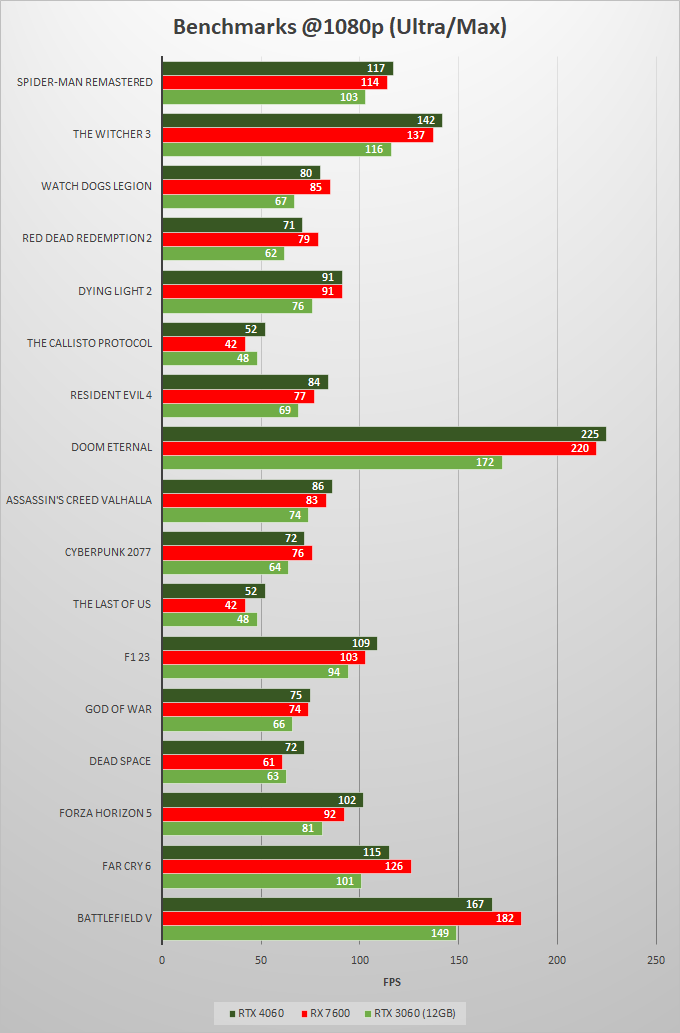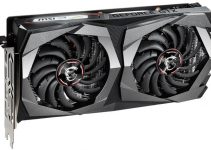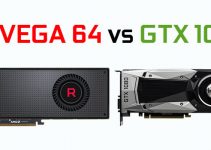The launch of the RTX 4060 has made the mid-range segment of the GeForce RTX 40 graphics card series from Nvidia a bit more interesting and promising. RTX 4060 can be said to be the successor of the RTX 3060 if we compare the model numbers from one series to another. RTX 4060 card sits below the recently launched RTX 4060 Ti and is targeted towards fast 1080p gaming at maximum graphics settings. However, you can also enjoy 1440p gaming at 60 FPS or more if you can lower some of the intensive graphics settings depending on the AAA game you are playing. The closest competitor of RTX 4060 is the RX 7600 from AMD which is also a great 1080p gaming card and is priced slightly lower. So, if you want to find out how RTX 4060 stacks against the RX 7600 and RTX 3060 12GB then below you can find the comparison between them based on important parameters.
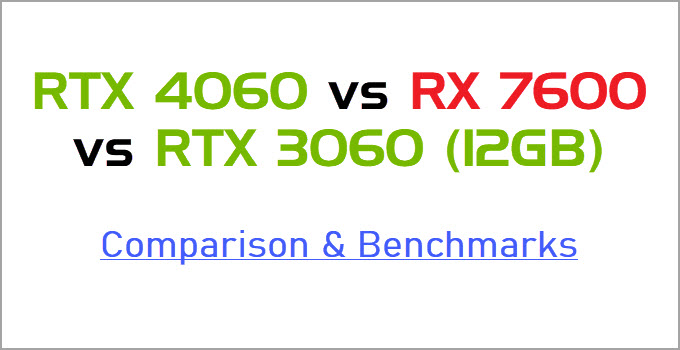
RTX 4060 vs RX 7600 vs RTX 3060 (12GB) Comparison
Below is a quick comparison between RTX 4060, RX 7600, and RTX 3060 (12GB) graphics cards based on their specifications, performance, pricing, power consumption, and features.
GPU Architecture
RTX 4060 is built on the latest Ada Lovelace architecture on a smaller 5nm fabrication process. The card uses AD107 GPU and comes with 3072 CUDA Cores, 24 RT Cores (3rd Generation), and 96 Tensor Cores (4th Generation). On the other hand, RTX 3060 (12GB) is built on the relatively older Ampere GPU architecture on an 8nm fabrication process. It comes with 3584 CUDA Cores, 28 RT Cores (2nd Generation), and 112 Tensor Cores (3rd Generation).
Radeon RX 7600 is an AMD graphics card that uses its latest RDNA 3 GPU architecture and is built on a 6nm fabrication process. The card uses Navi 33 XL GPU and comes with 2048 Stream Processors, 32 Ray Accelerators, and 64 AI Accelerators.
Must Read: CUDA Cores vs Stream Processors Difference
| RTX 4060 | RX 7600 | RTX 3060 (12GB) |
|
| GPU Chip | AD107 | Navi 33 XL | GA106 |
| GPU Architecture | Ada Lovelace | RDNA 3 | Ampere |
| Fabrication Process | 5nm | 6nm | 8nm |
| CUDA Cores/Stream Processors | 3072 CUDA Cores | 2048 Stream Processors | 3584 CUDA Cores |
| RT Cores | 24 (3rd Gen.) | 32 | 28 (2nd Gen.) |
| Tensor Cores | 96 (4th Gen.) | 64 | 112 (3rd Gen.) |
Video RAM [VRAM]
The card with the largest and fastest memory is the RTX 3060 12GB as it comes with 12GB GDDR6 memory having a 192-bit interface. The memory runs at a speed of 15Gbps and delivers a memory bandwidth of 360 GB/s. On the other hand, both RTX 4060 and RX 7600 come with 8GB GDDR6 memory having a 128-bit interface but have different speeds. RX 7600 comes with slightly faster memory with a speed 18Gbps and delivers a memory bandwidth of 288 GB/s. Moreover, it comes with a 32MB Infinity Cache, an ultra-fast memory cache, and with its help, the card can deliver much higher peak memory bandwidth. RTX 4060 has a memory speed of 17Gbps and delivers 272 GB/s of memory bandwidth.
| RTX 4060 | RX 7600 | RTX 3060 (12GB) |
|
| Memory Size | 8GB GDDR6 | 8GB GDDR6 | 12GB GDDR6 |
| Memory Interface | 128-bit | 128-bit | 192-bit |
| Memory Speed | 17Gbps | 18 Gbps | 15 Gbps |
| Memory Bandwidth | 272 GB/s | 288 GB/s | 360 GB/s |
| Infinity Cache | NA | 32MB | NA |
Features
All three graphics cards support DirectX 12 Ultimate, OpenGL 4.6, and Vulkan and support variable refresh rate technologies (G-Sync/FreeSync) to reduce stuttering in games for a butter smooth gaming experience, PCIe 4.0, Real-Time Ray Tracing, HDMI 2.1, AV1 decoding. RTX 4060 and RX 7600 are the only ones that support AV1 Encoding. Moreover, while RTX 3060 12GB supports PCIe 4.0 x16, RTX 4060 and RX 7600 are limited to PCIe 4.0 x8 lanes only limiting PCI-Express bandwidth, and it may pose performance issues, especially with motherboards supporting PCIe 3.0 interface only.
RX 7600 is the only card here that supports DisplayPort 2.1 while others support DisplayPort 1.4a only. When it comes to image upscaling technology to increase performance/FPS in games, RTX 4060 and RTX 3060 support DLSS (Deep Learning Super Sampling). RTX 4060 supports the latest version of DLSS which is DLSS 3 while RTX 3060 supports DLSS 2. On the other hand, the Radeon RX 7600 supports AMD FidelityFX Super Resolution (FSR) as its image-upscaling technology.
| RTX 4060 | RX 7600 | RTX 3060 (12GB) |
|
| Bus Interface | PCI Express 4.0 (x8) | PCI Express 4.0 | PCI Express 4.0 |
| DirectX | 12 Ultimate | 12 Ultimate | 12 Ultimate |
| OpenGL | 4.6 | 4.6 | 4.6 |
| Vulkan | 1.2 | 1.2 | 1.2 |
| SLI / CrossFire | NA | NA | NA |
| VR Ready | Yes | Yes | Yes |
| G-Sync/FreeSync | Yes | Yes | Yes |
| HDMI 2.1 | Yes | Yes | Yes |
| DisplayPort 2.1 | No | Yes | No |
| AV1 Support (Encode/Decode) | Yes | Yes | Decode only |
| Real-Time Ray Tracing | Yes | Yes | Yes |
| Deep Learning Super Sampling (DLSS) | DLSS 3 | NA | DLSS 2 |
| FidelityFX Super Resolution (FSR) | Yes | Yes FSR 2 | Yes |
Gaming Performance
Here are the gaming benchmarks of these cards at 1440p and 4K resolution in the latest AAA games.
1080p Gaming Benchmarks
1440p Gaming Benchmarks
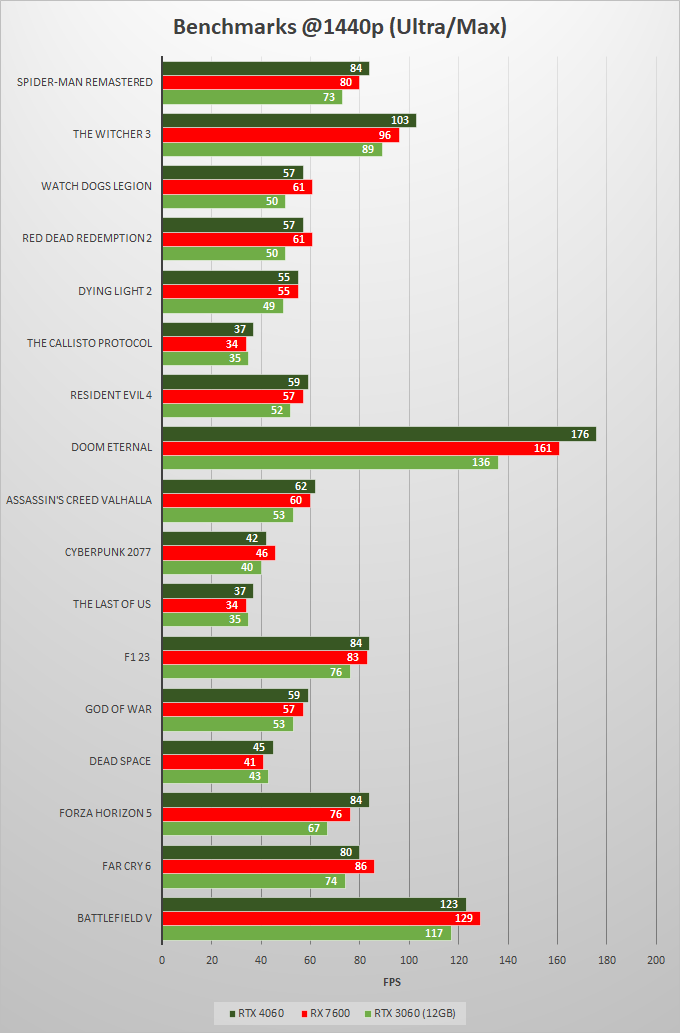
From the above gaming benchmarks, we can see that on average, RTX 4060 is only 3 to 4 percent faster than RX 7600 and is around 15% faster than the RTX 3060.
Power Consumption
RTX 4060 is the most power-efficient card here with total graphics power (TGP) of 115W only. The maximum power consumption figures of RX 7600 and RTX 3060 are almost the same at 165W and 170W respectively.
| RTX 4060 | RX 7600 | RTX 3060 (12GB) | |
| Power Consumption | 115W | 165W | 170W |
| Recommended PSU | 550W | 550W | 550W |
Pricing & Availability
Talking about the official base MSRP, RTX 4060 is priced at USD 299, RX 7060 at USD 269, and RTX 3060 (12GB) at USD 329. The price of RTX 3060 12GB has dropped significantly with time and now you can find some models at around USD 280. The AIB custom models of these cards may cost more and you can check the current prices from the links below.
Check RTX 4060 Price on Amazon
Check RTX 3060 12GB Price on Amazon
RTX 4060 vs RX 7600 vs RTX 3060 (12GB) Specifications
| RTX 4060 | RX 7600 | RTX 3060 (12GB) |
|
| GPU Chip | AD107 | Navi 33 XL | GA106 |
| GPU Architecture | Ada Lovelace | RDNA 3 | Ampere |
| Fabrication Process | 5nm | 6nm | 8nm |
| CUDA Cores/Stream Processors | 3072 CUDA Cores | 2048 Stream Processors | 3584 CUDA Cores |
| RT Cores | 24 | 32 | 28 |
| Tensor Cores | 96 | 64 | 112 |
| Memory Size | 8GB GDDR6 | 8GB GDDR6 | 12GB GDDR6 |
| Memory Interface | 128-bit | 128-bit | 192-bit |
| Memory Speed | 17Gbps | 18 Gbps | 15 Gbps |
| Memory Bandwidth | 272 GB/s | 288 GB/s | 360 GB/s |
| Bus Interface | PCI Express 4.0 (x8) | PCI Express 4.0 (x8) | PCI Express 4.0 |
| DirectX | 12 Ultimate | 12 Ultimate | 12 Ultimate |
| OpenGL | 4.6 | 4.6 | 4.6 |
| Vulkan | 1.2 | 1.2 | 1.2 |
| SLI / CrossFire | NA | No | No |
| VR Ready | Yes | Yes | Yes |
| G-Sync/FreeSync | Yes | Yes (FreeSync) | Yes (G-Sync) |
| Power Consumption | 115W | 165W | 170W |
| Recommended PSU | 550W | 550W | 550W |
See also:
Final Thoughts
Well RTX 4060 could have been a very good proposition if it was priced slightly below its current base MSRP. Its close competitor RX 7600 offers the same amount of performance with being cheaper too. Also, RTX 3060 12GB with its reduced pricing can be a very good option to consider who want more VRAM for their specific requirements. The only great thing about RTX 4060 is its relatively lower power consumption but the power consumption figures of RX 7600 and RTX 3060 12GB are also on the lower side. If you have anything to add here or have any queries then please let me know in the comment section below.
(*This post may contain affiliate links, which means I may receive a small commission if you choose to purchase through the links I provide (at no extra cost to you). Thank you for supporting the work I put into this site!)
